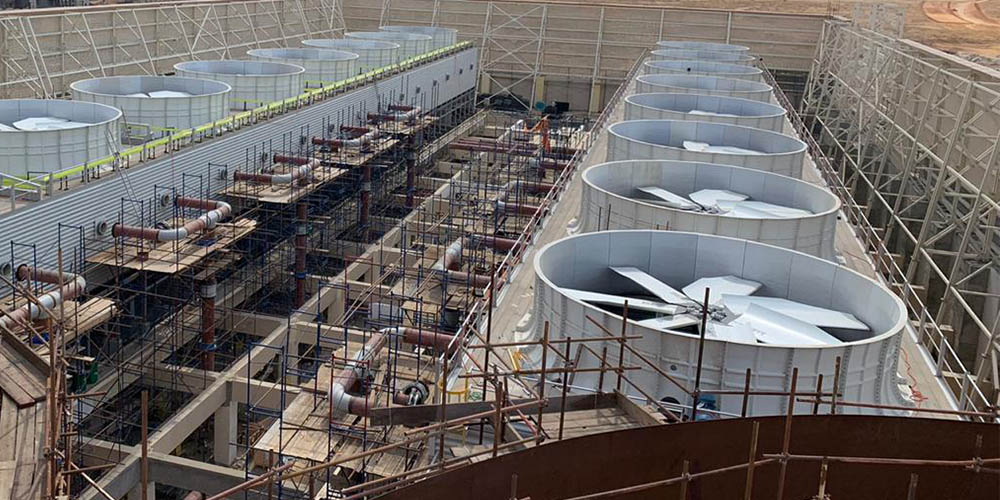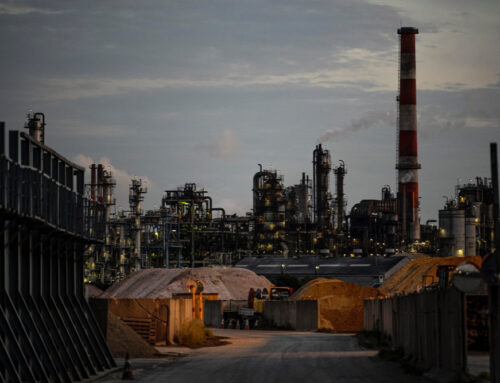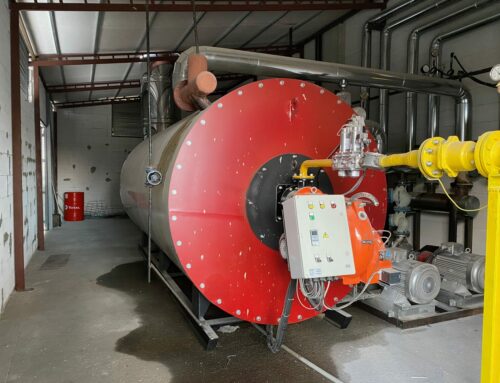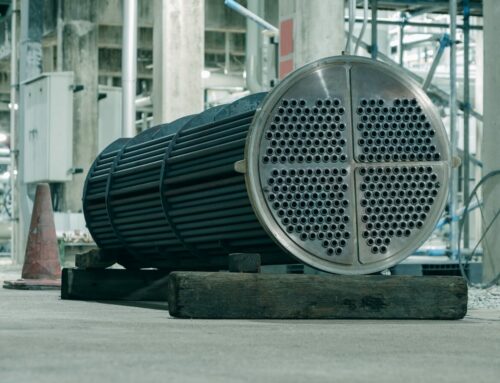Cooling is the process of transferring thermal energy from one medium to another. In industrial applications, cooling is critical to avoid overheating of working equipment or products. Many applications have a working principle that uses water to absorb heat. Cooling applications can be realized thanks to these systems that utilize the boiling point and specific heat of water.
There are many methods of installing industrial cooling tower systems. When choosing methods, it is necessary to examine how the systems use cooling water and designs should be made accordingly.
Water is used as the transfer medium in the design of cooling systems. In these systems, where the boiling point and specific heat of water are utilized, water cooling towers are required for continuous processes. Understanding the type of system you need to use for the methods you apply for cooling processes will help you determine the most effective water cooling plan for your processes.
What is a Cooling Tower?
A water cooling tower is a containment system that allows heat to pass through a process liquid and separate it from the ambient air through evaporation. Water is generally preferred as the process liquid. The process is carried out by contacting a very large surface area with a rapidly moving air stream in the water system. Cooling tower; It is suitable for use in many areas through heat pumps that take their source from water.
The cooling tower can also be said to be a heat rejection device that helps to achieve a lower temperature with the flow of water and releases heat to the atmosphere as waste. The type of heat rejection inside is called an evaporator. Even a small amount of water involved in the cooling process has a significant effect.
For the cooling effect, evaporation into a moving air stream takes place. The heat transferred from the water stream to the air stream causes the temperature and relative humidity of the air to rise. Air with rising temperature and relative humidity is discharged into the atmosphere as waste. The need for chilled water is met by evaporation-based heat rejection devices operating on the principle of cooling towers. Common applications for air-cooled systems and cooling towers are air conditioners, cooling water used for manufacturing and electrical power generation.
What are the Benefits of Using a Cooling Tower?
Evaporative heat dissipation devices such as cooling towers generally produce significantly lower temperatures than air-cooled and dry heat dissipation devices. Thanks to cooling towers, the system can be obtained at more affordable costs. In addition to the system cost, a more efficient cooling is realized in terms of energy.
Thanks to cooling towers; much more water and energy savings can be achieved compared to air-cooled HVAC or process cooling systems. For example, running a 200-ton air-cooled system can require 50 percent more energy than running a 200-ton water-cooled system.
Costs can be minimized in buildings and cold storages with the right cooling system program preferred for your needs. At the same time, thanks to the use of the preferred cooling system, a more efficient output can be obtained in terms of industrial systems. It is possible to save energy while increasing efficiency.
In order to ensure that cooling towers operate at high efficiency and to reduce the duration of malfunctions that may occur, appropriate maintenance should be carried out periodically. Otherwise, failure to save water, corrosion, calcification, sediment formation and microbiological activities may occur. Evaporated water can leave behind concentrated sediments that cause sediment and corrosion. These deposits can lead to production interruptions, extra costs and reduced production efficiency.
Failures of water equipment that must be used in production can also be one of the problems you may encounter. Problems that may occur can be reduced to low levels if professional and quality devices, expert support-oriented development and qualified applications in the sector are carried out. As a result of these applications and measures taken, lime formation and contamination that impairs efficiency can be controlled.
The growth of epidemic-level harmful microbes and microorganisms caused by bacteria, which are potentially fatal, can also occur. Maintenance is important to prevent this. Assessments are particularly important for the outbreak of Legionella. Regular reviews and a regular risk assessment plan should be in place to check suitability for production.
How Does a Cooling Tower Work?
Water cooling towers take the hot water coming from the plant and spray it homogeneously up and down in the tower with carefully manufactured water distribution systems. The water masses that meet with the cooling tower by spraying are subjected to filtration through the fillings of the tower. The percolation process breaks down the masses and breaks them into smaller pieces.
Air with ambient humidity is sucked from bottom to top over the fills through the motor fan group in the system. The water that meets the air on the surface of the filling cooling system cools down by giving its heat to the air and a very small part of it evaporates and separates. After evaporation, the cooled water is collected in the cold water pool and sent to be processed again. When the air, whose humidity increases with the evaporation of the water, approaches the degree of saturation, it is discharged into the atmosphere through the fan chimney on the tower.
Open and Closed Circuit Cooling Tower
Cooling towers are divided into open type and closed type. Partial differences in their working principles, the needs of the enterprises and the differences in their costs are effective in preferences.
Open water cooling towers perform the water cooling process by giving heat from the system to the atmosphere. The hot process water is transferred to the interface through the heat transfer medium by means of air and fan blown from the water cooling tower. During the cooling process, only a small portion of the water evaporates while the rest of the process water is cooled. The water cooled by the cooling water is sprayed into the air. The air is then heated to create a chimney effect and the water is energized. Cooling towers operating with wet cooling have a very high power density. Water loss that may occur during evaporation is minimized thanks to mist eliminators.
Closed type cooling towers, which can also be said indirectly, do not come into direct contact with air. The liquid is usually cooled by water and an insulated mixture. Unlike open cooling towers, indirect cooling towers have two separate liquid circuits. The first circuit consists of pipes connected to the process to cool the water and rotate it within the closed circuit, and an external circuit that rotates outside the circuit. Air is drawn through the circulating water by pushing it out of the hot tubes, providing a process similar to an open cooling tower.
Indirect cooling towers are very similar to open cooling towers with one exception. The cooled process fluid is closed in the circuit. It has no direct exposure to the atmosphere or recirculated outside water.
Energy Efficient Affordable Cooling Tower Costs
Frequently used open type and closed type water cooling towers have different advantages and disadvantages. Among the towers, open type water cooling towers are generally among the most preferred cooling towers.
Open cooling towers have a lower initial installation cost than closed cooling towers. However, costs may increase if any filtration or other equipment is needed. Fouling, especially in the heat exchanger, can significantly reduce performance and efficiency.
The advantages of open-circuit cooling towers are that they can be used for different water flow rates and that they can be used for a long time thanks to their durable materials.
The advantages of closed cooling towers are that they create a pollutant-free cooling circuit. Closed type cooling towers also allow operation in winter. System maintenance is as low as possible. Overall system costs are reduced to very low levels due to maintenance, water and energy savings throughout the year.
The disadvantage of open circuit cooling towers is that a strict cleaning program is required to maintain heat transfer. Otherwise, open cooling towers can incur extra water treatment and filter costs, which increase the operating cost to very high levels.
Closed cooling towers have a high initial installation cost. Although system maintenance costs are low, the high initial installation cost prevents them from being preferred.
Conclusion
At Sanarise Industrial, we pride ourselves on being a reliable supplier of eco-friendly cooling towers, tailored to meet the unique needs of our clients. Our commitment to providing high-quality products and services ensures that our customers receive the most efficient and effective cooling solutions for their industrial applications.
By choosing Sanarise Industrial as your cooling tower supplier, you not only receive state-of-the-art cooling technology but also contribute to a greener and more sustainable future. Our team of experts is dedicated to helping you find the perfect cooling tower solution for your business while minimizing environmental impact.
As the demand for sustainable and energy-efficient solutions grows, Sanarise Industrial remains at the forefront of innovation in the cooling tower industry. Contact us today to learn more about our wide range of environmentally friendly cooling towers and discover how we can help your business achieve its energy efficiency and sustainability goals.






Leave A Comment